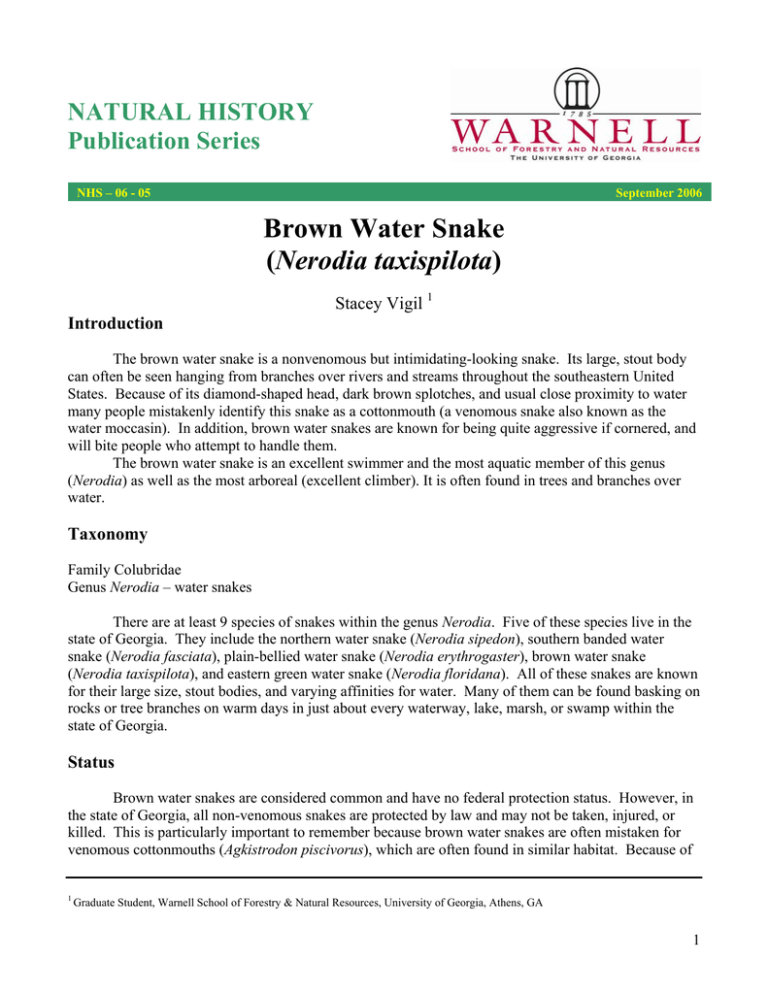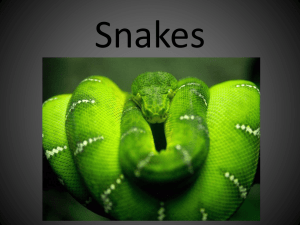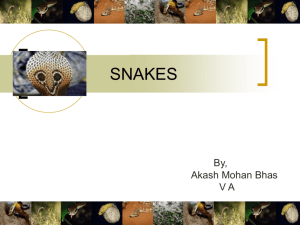Brown Water Snake Nerodia taxispilota NATURAL HISTORY
advertisement

NATURAL HISTORY Publication Series NHS – 06 - 05 September 2006 Brown Water Snake (Nerodia taxispilota) Stacey Vigil 1 Introduction The brown water snake is a nonvenomous but intimidating-looking snake. Its large, stout body can often be seen hanging from branches over rivers and streams throughout the southeastern United States. Because of its diamond-shaped head, dark brown splotches, and usual close proximity to water many people mistakenly identify this snake as a cottonmouth (a venomous snake also known as the water moccasin). In addition, brown water snakes are known for being quite aggressive if cornered, and will bite people who attempt to handle them. The brown water snake is an excellent swimmer and the most aquatic member of this genus (Nerodia) as well as the most arboreal (excellent climber). It is often found in trees and branches over water. Taxonomy Family Colubridae Genus Nerodia – water snakes There are at least 9 species of snakes within the genus Nerodia. Five of these species live in the state of Georgia. They include the northern water snake (Nerodia sipedon), southern banded water snake (Nerodia fasciata), plain-bellied water snake (Nerodia erythrogaster), brown water snake (Nerodia taxispilota), and eastern green water snake (Nerodia floridana). All of these snakes are known for their large size, stout bodies, and varying affinities for water. Many of them can be found basking on rocks or tree branches on warm days in just about every waterway, lake, marsh, or swamp within the state of Georgia. Status Brown water snakes are considered common and have no federal protection status. However, in the state of Georgia, all non-venomous snakes are protected by law and may not be taken, injured, or killed. This is particularly important to remember because brown water snakes are often mistaken for venomous cottonmouths (Agkistrodon piscivorus), which are often found in similar habitat. Because of 1 Graduate Student, Warnell School of Forestry & Natural Resources, University of Georgia, Athens, GA 1 the public’s fear of venomous snakes and an inability to differentiate brown water snakes from cottonmouths, many brown water snakes are killed for no reason. Description The distinguishing characteristics of a brown water snake include a large, heavy body and a head visibly wider than the neck, giving the head a slightly triangular appearance. Adults have large, dark brown blotches on a lighter brown background. The dorsal pattern looks like one line of square splotches down the center of the back and a lateral line of splotches in an alternating pattern down either side of the body. In older snakes, this pattern may be very dark brown with the splotches only being barely visible. The belly is lighter than the back, usually yellow to medium brown. It may also have a varying pattern of brown splotches and black crescents or trapezoids. Brown water snakes are large snakes that can reach a total length of 30 to 55 inches. The longest one on record was almost 70 inches long. Females are significantly larger than males—up to one-third longer and 2 to 5 times as heavy. This size difference is due to the fact that females need to increase their body fat by 50% to ovulate. They then carry their eggs internally until the young are ready to hatch. Distribution The brown water snake is native to the Coastal Plain and some of the Piedmont of the southeastern United States. It can be found as far north as Virginia, south through all of Florida, and west to extreme southeastern Alabama. In Georgia, it can be found throughout the Coastal Plain and most of the central Piedmont except for a small section of northeastern Georgia on the border with South Carolina. It is also not found in extreme northern and northwestern Georgia. Form and Function The brown water snake has 27 to 33 rows of strongly keeled scales and a divided anal plate. The keeled scales often gather mud and dirt and may obscure the brown water snakes distinct pattern, making them look almost solid brown and very well camouflaged. The brown water snake also has 136-152 belly scales and an abruptly tapering tail. Its eyes sit high on its head and close to the tip of the nostrils allowing it to see and breathe easily above 2 the water while keeping most of its body under the water while swimming. Brown water snakes have a definite sexual dimorphism based on adult size. One study from Virginia showed that males averaged 24 inches in length and 6.5 ounces in weight. Females however, averaged 32 inches in length and 11 ounces in weight—and gravid (pregnant) females weighed an average of 35 ounces! Ecology Like most snakes, the brown water snake is a carnivore and predator. It is at or near the top of the food chain in its environment. Therefore it plays an important role in regulating populations of its prey and helps to maintain a balance in its environment. Reproduction: Female brown water snakes have to significantly increase their body fat (to about 50%) in order to ovulate and produce eggs. They are ovoviviparous, meaning that they hold their eggs internally until they hatch then give birth to live young. All of that extra body fat goes toward creating egg yolks (which each individual baby feeds off of while developing inside the mother snake) for up to 60 babies. Because they become so large when preparing for pregnancy, female brown water snakes may have to resort to scavenging for carrion to keep up with the tremendous demand on their bodies. Mating occurs in the springtime often in the branches of low-hanging trees. Male brown water snakes seek out females by following their scent trails, and up to three male snakes often attempt to mate with the same female. After the young grow within their individual egg sacs inside the female for a couple of months they are born live and are about 7 to 10 inches in length. They are typically born on land and look like miniature adults. Feeding: Brown water snakes feed mainly on fish but also will eat other aquatic prey such as frogs. Catfish are a favorite prey item. Some snakes have actually been seen with catfish spines protruding from their body. The spines eventually break down and the snake heals with no further injury. Brown water snakes, like other species of water snake, have a unique way of catching their prey. They will hang down from branches over a water source waiting for fish to swim beneath them. When a fish is within striking range the water snake is able to capture it and swallow it alive. Water snakes also actively forage among underwater rocks and debris for prey. Behavior: Brown water snakes are excellent climbers and can often be found 20 feet or more up a tree, and most often on branches overhanging the water. They may also be found on large rocks or bushes over the water. This behavior, called basking, allows the ectothermic snake to warm its body in the sunlight increasing its metabolism and activity. If startled, they will leap into the water and may accidentally end up in a boat. Once in the water, they are excellent swimmers and can stay submerged for very long periods of time. They are particularly aggressive snakes that can flatten out their neck and may strike viciously if cornered. They typically also release a foul-smelling musk if threatened or handled. Brown water snakes are active both in the day and at night. However, during the hottest part of the year the snakes may become more nocturnal. In the northern reaches of their range brown water snakes may hibernate in holes and under rocks next to a water source. They awaken from hibernation when the water rises and they are forced to emerge from their hiding places. Habitat: Brown water snakes are usually found in the slow moving water of canals and rivers, and sometimes in lakes. The species is also found in cypress swamps and even occasionally in brackish 3 waters, particularly when there is a lot of overhanging vegetation. They will often bask on logs, branches, or bushes above the water and quickly retreat to the water if threatened. Enemies: Brown water snakes fall prey to many animals in the wetlands they inhabit. Alligators, large fish, predatory birds, and cottonmouths will all eat them. The young fall prey to even more creatures like smaller fish, other snakes, and even large frogs. Roads near waterways are particularly dangerous to brown water snakes. The snakes will often patrol along roads in the springtime where they can easily capture frogs and toads. This attraction to roads often leads many brown water snakes to their deaths. Humans are probably the greatest threat and enemy to this snake. General: Because brown water snakes are often confused with venomous cottonmouths it is important to be able to tell the two species apart. Brown water snakes are brown have round pupils while cottonmouths, that are often more greenish, have vertically elliptical pupils. In addition, cottonmouths have a facial pit between the eye and nostril and will hold their mouths open exposing the bright white interior when threatened. Finally, brown water snakes swim partially under the water and will often dive beneath the water; while cottonmouths will always keep their head well above the water and do not dive. The best advice though if you see a snake in the wild is to leave it alone, especially if you are not completely sure that it is not venomous. Even the nonvenomous brown water snake can leave a person with a nasty bite. Populations: Brown water snakes are sometimes extremely densely distributed in favored areas, such as rivers with significant overhanging branches from trees. One mark-recapture study estimated their density at 69 individuals per mile of river habitat. In most areas their numbers are probably closer to 12 snakes per acre of wetland habitat. Disease Brown water snakes are not known to transmit any diseases to humans. However, some people bitten by brown water snakes experience irritation at the bite site due to the combination of complex proteins and microorganisms that can be present in the snake’s saliva. Economic Value Brown water snakes have no known direct economic value to humans. However, they are a valuable member of southern wetland ecosystems which would not be the same without this species. Damage Brown water snakes do not cause any damage to human agriculture, livestock, or structures. While they will consume fish from stocked ponds the total damage is generally small. Medicinal Value Brown water snakes do not have any known past or present medicinal value. 4 Legal Aspects All nonvenomous snakes are protected in the state of Georgia. It is illegal to capture, sell, injure, or kill any nonvenomous snake in Georgia. Control to Reduce If there are large waterways and prey species available, it is very hard to reduce brown water snake populations. Altering stream banks is not recommended. Landowners should protect water quality by protecting streams and stream banks by maintaining a 50-foot buffer of natural vegetation on either side of a stream. Physical removal of snakes is also an option, but because of their aggressive nature and possible confusion with the cottonmouth, handling of brown water snakes by a nonprofessional is not recommended. It also may be possible to capture water snakes using a trap (making sure the captured snake is able to come to the surface to breathe if the trap is placed underwater), but again, a professional should be contacted to help with this technique and make sure the correct permits are acquired. Remember, it is against the law to kill any nonvenomous snake in the state of Georgia, including the brown water snake. Management to Enhance Conserving natural habitat surrounding major waterways and wetlands, and keeping them free from garbage and chemicals is the best way to enhance brown water snake populations. Human Use Native Americans – Brown water snakes were hunted and eaten. Colonists – no known uses. Further Reading Gibbons, J. W. and M. E. Dorcas. 2004. North American Water snakes: A Natural History. University of Oklahoma Press. Norman, OK 438 p. Gibbons, J. W. and M. Dorcas. 2005. Snakes of the Southeast. Athens: The University of Georgia Press. 253 p. Conant, R. and J. T. Collins. 1998. A Field Guide to Reptiles and Amphibians of Eastern and Central North America. 3rd Edition, expanded. New York: Houghton Mifflin Company. 616 p. Tennant, A. and R. D. Bartlett. 2000. Snakes of North America; Eastern and Central Regions. Houston: Gulf Publishing Company. 588 p. Acknowledgements The thoughtful reviews provided by Dr. John Maerz, Assistant Professor – Wildlife (Herpetology) and Ms. Natalie Hyslop, Ph.D. candidate in the Warnell School of Forestry and Natural Resources are appreciated. 5 Editor Michael T. Mengak, Associate Professor – Wildlife Specialist Warnell School of Forestry and Natural Resources Athens, Georgia 30602-2152 Telephone 706.542.2686 Fax 706.542.8356 In compliance with federal law, including the provisions of Title IX of the Education Amendments of 1972, Title VI of the Civil Rights Act of 1964, Sections 503 and 504 of the Rehabilitation Act of 1973, and the Americans with Disabilities Act of 1990, the University of Georgia does not discriminate on the basis of race, sex, religion, color, national or ethnic origin, age, disability, or military service in its administration of educational policies, programs, or activities; its admissions policies; scholarship and loan programs; athletic or other University-administered programs; or employment.. In addition, the University does not discriminate on the basis of sexual orientation consistent with the University non-discrimination policy.. Inquiries or complaints should be directed to the director of the Equal Opportunity Office, Peabody Hall, 290 South Jackson Street, University of Georgia, Athens, GA 30602.Telephone 706-542-7912 (V/TDD).Fax 706-542-2822 6





